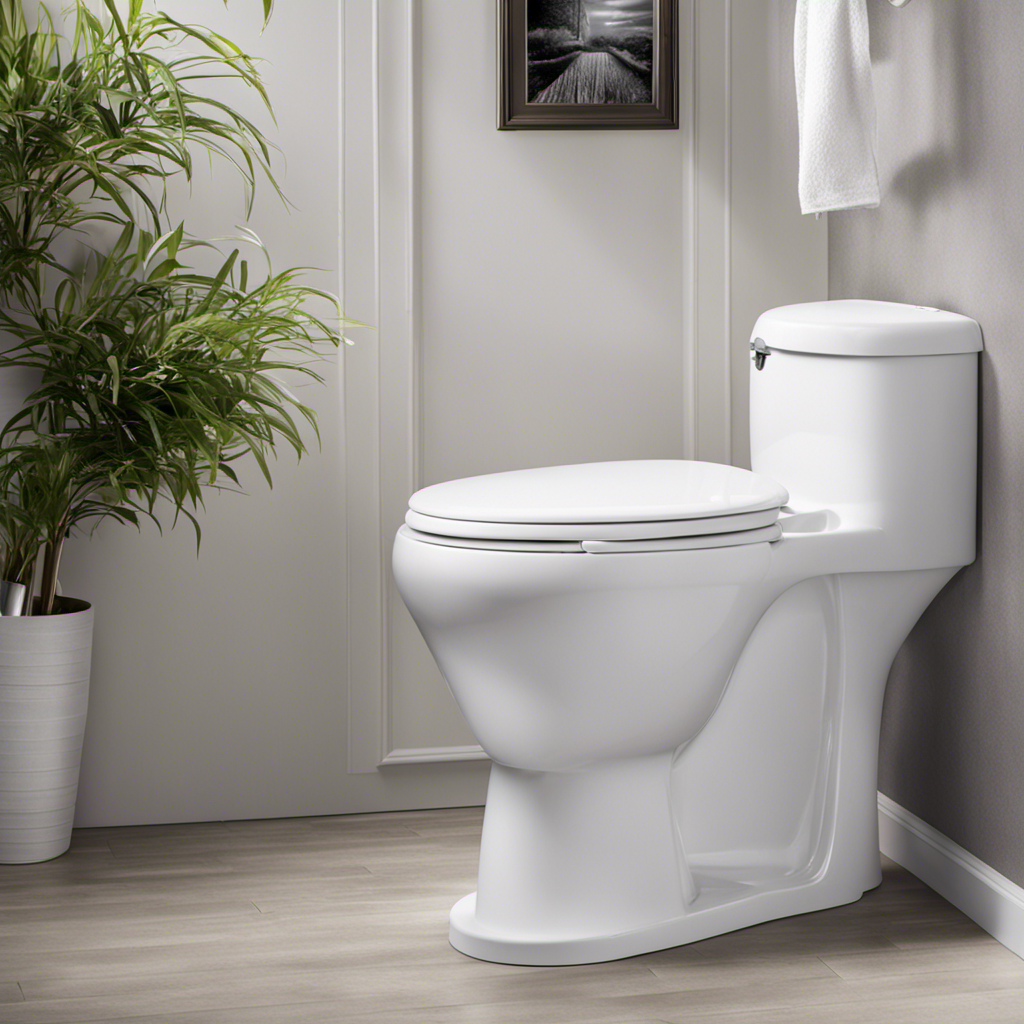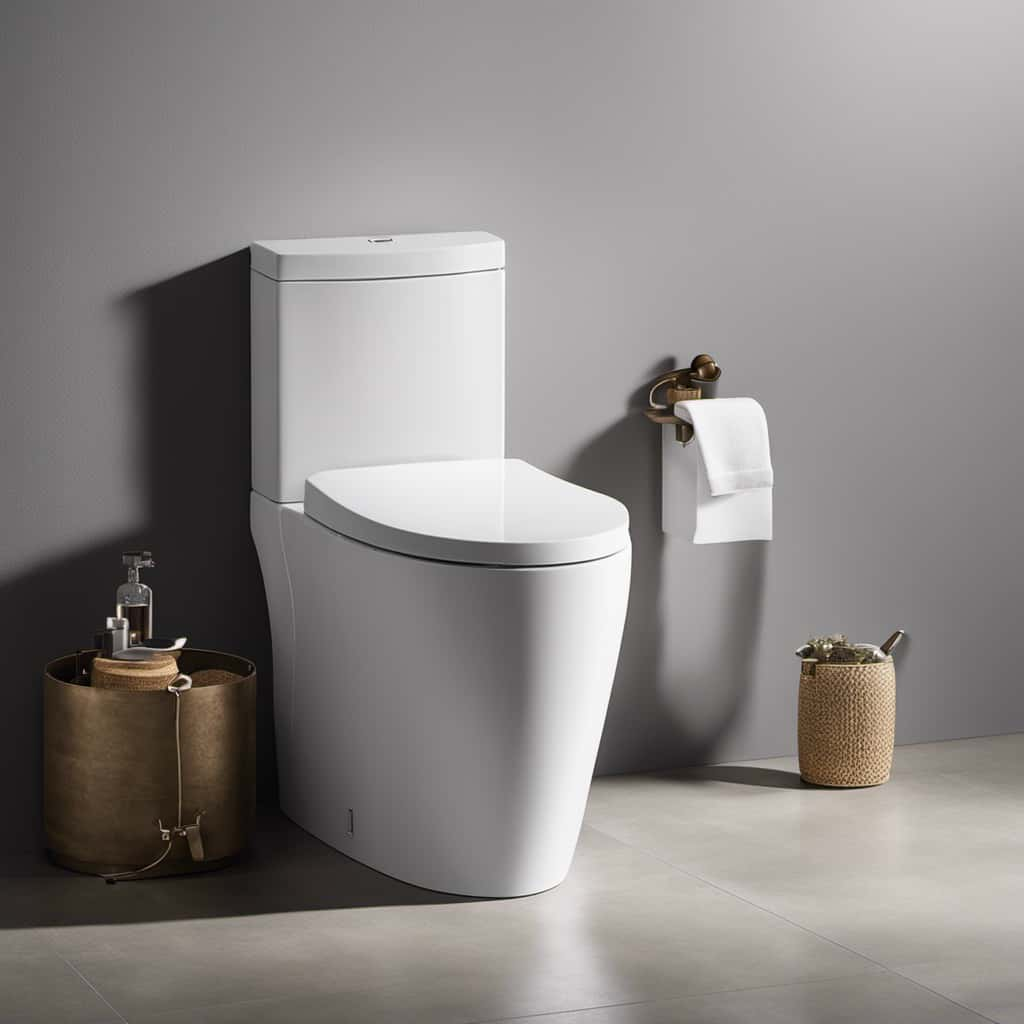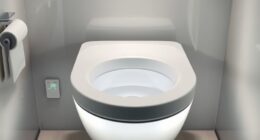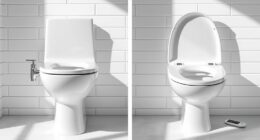I’ve struggled with stubborn toilet stains for years, and I know how frustrating it can be. But fear not! I’ve discovered effective methods to get rid of those unsightly marks and restore your toilet to its former glory.
In this article, I’ll share step-by-step instructions on how to tackle hard water stains, rust stains, mineral deposits, mold, and mildew stains. By following these tips, you’ll be able to maintain a clean and stain-free toilet bowl that will leave you feeling relieved and proud.
Key Takeaways
- Hard water and mineral deposits are the main causes of toilet stains.
- Regular cleaning and maintenance can prevent toilet stains.
- Installing a water softener system can reduce mineral buildup and prevent stains.
- Using toilet bowl cleaners designed to remove stains can effectively prevent and remove toilet stains.
Understanding the Causes of Toilet Stains
Toilet stains can be caused by a variety of factors, such as hard water or mineral deposits. Prevention is key when it comes to avoiding these unsightly stains. Regular cleaning and maintenance can help keep your toilet free from stains.
To prevent hard water stains, consider installing a water softener system to reduce mineral buildup. Additionally, using toilet bowl cleaners specifically designed to remove stains can help prevent them from forming in the first place.
If you do find yourself facing stubborn stains, there are several DIY stain removal methods you can try. For example, a mixture of baking soda and vinegar can be effective in removing stains. Simply apply the paste to the stained area, let it sit for a few minutes, and then scrub with a toilet brush.
Choosing the Right Cleaning Products for Your Toilet
When choosing the right cleaning products for your toilet, it’s important to consider their effectiveness and compatibility with your specific needs. There are a wide variety of options available in the market, each claiming to be the best. To help you make an informed decision, I have compiled a table showcasing the top three toilet cleaning tools and their key features:
| Cleaning Tool | Effectiveness | Compatibility |
|---|---|---|
| Toilet Bowl Cleaner | Effectively removes stains and kills germs | Suitable for all types of toilets |
| Toilet Brush | Scrubs away stubborn stains | Compatible with most toilet bowls |
| Pumice Stone | Removes tough mineral deposits and rust stains | Ideal for porcelain and ceramic toilets |
In addition to using these tools, there are some toilet cleaning hacks that can further enhance your cleaning routine. For example, using vinegar and baking soda as natural alternatives, or placing denture tablets in the toilet tank to keep it clean and fresh. Remember to always read the instructions and follow safety precautions when using cleaning products.
Step-By-Step Guide to Removing Hard Water Stains
When it comes to dealing with hard water stains, it’s important to know the most effective stain removal techniques.
In this discussion, I will guide you through step-by-step instructions on how to tackle these stubborn stains and restore the cleanliness of your surfaces.
Additionally, I will provide useful tips on preventing future water stains, ensuring that you can maintain a spotless environment for longer periods.
Effective Stain Removal Techniques
One effective technique for getting rid of stubborn stains is to use a mixture of baking soda and vinegar. This combination is a popular choice among stain removal hacks and DIY toilet cleaners.
To use this method, start by pouring half a cup of baking soda directly into the toilet bowl. Next, add one cup of vinegar slowly to the bowl. Allow the mixture to sit for at least 30 minutes, or overnight for tougher stains.
The fizzing action of the baking soda and vinegar will help break down the stains and remove any unpleasant odors. After the allotted time, scrub the bowl with a toilet brush and flush to reveal a sparkling clean toilet.
This simple yet effective technique is a great alternative to commercial cleaners and is safe for both your health and the environment.
Preventing Future Water Stains
To prevent future water stains, you should regularly wipe down surfaces with a mixture of vinegar and water. This simple solution is effective in preventing discoloration and maintaining the cleanliness of your bathroom.
Here are three additional tips to help you in your quest for water stain prevention:
-
Use a squeegee: After each shower or bath, use a squeegee to remove excess water from your shower walls and glass doors. This will prevent water droplets from drying and leaving behind unsightly stains.
-
Install a water softener: Hard water can contribute to water stains. By installing a water softener, you can reduce the mineral content in your water, minimizing the likelihood of stains.
-
Seal grout lines: Grout lines can absorb water and become discolored over time. Applying a grout sealer can help protect the grout from water penetration and prevent staining.
Eliminating Rust Stains From Your Toilet Bowl
When it comes to eliminating rust stains from your toilet bowl, there are several key points to consider.
First and foremost, you need to find an effective rust stain remover that will effectively break down and remove the stubborn stains.
Additionally, it is important to take preventive measures to avoid future rust stains, such as using a toilet tank cleaner that helps prevent rust buildup.
Lastly, if you prefer natural cleaning solutions, there are also eco-friendly options available that can effectively remove rust stains without the use of harsh chemicals.
Effective Rust Stain Removers
You can easily remove those stubborn rust stains in your toilet using effective rust stain removers. Here are some options to consider:
-
Lemon juice: The citric acid in lemon juice can help dissolve rust stains. Simply squeeze fresh lemon juice onto the stain, let it sit for a few minutes, and scrub with a brush.
-
Vinegar and baking soda: Create a paste by mixing vinegar and baking soda. Apply the paste to the stain, let it sit for a while, and then scrub with a brush.
-
Borax: Mix borax with lemon juice or vinegar to form a paste. Apply the paste to the stain, let it sit for a few hours or overnight, and then scrub.
Using natural rust removers like these DIY stain removal techniques can be effective in getting rid of those unsightly rust stains in your toilet. However, it’s also important to take steps to prevent future rust stains.
Preventing Future Rust Stains
Now that we know how to effectively remove rust stains from toilets, let’s talk about preventing future rust stains. Prevention is key when it comes to maintaining a clean and stain-free toilet. By taking a few simple steps, we can ensure long-term stain prevention and avoid the hassle of dealing with rust stains in the future.
One effective way to prevent rust formation is to regularly clean and dry the toilet bowl. Moisture is a breeding ground for rust, so wiping down the bowl after each use can help prevent the formation of rust stains. Additionally, using a toilet bowl cleaner that contains rust inhibitors can provide an extra layer of protection against rust.
To further enhance long-term stain prevention, consider using a toilet bowl coating or sealer. These products create a protective barrier on the surface of the toilet bowl, making it harder for rust stains to adhere and develop.
By following these preventive measures, you can enjoy a clean and stain-free toilet for a long time to come.
| Preventive Measures for Rust Stain Prevention |
|---|
| Regularly clean and dry toilet bowl |
| Use a toilet bowl cleaner with rust inhibitors |
| Apply a toilet bowl coating or sealer |
Natural Cleaning Solutions
To effectively prevent future rust stains, try using natural cleaning solutions that are safe and gentle on your toilet bowl. Here are some natural cleaning hacks and homemade cleaning solutions you can try:
-
Vinegar and Baking Soda:
-
Mix equal parts of vinegar and baking soda to form a paste.
-
Apply the paste to the stained areas of the toilet bowl.
-
Let it sit for a few minutes, then scrub with a toilet brush and flush.
-
Lemon Juice:
-
Squeeze fresh lemon juice onto the rust stains.
-
Let it sit for a few minutes to loosen the stains.
-
Scrub with a toilet brush and flush.
-
Borax and Lemon Juice:
-
Mix borax and lemon juice to form a paste.
-
Apply the paste to the stains and let it sit for a few minutes.
-
Scrub with a toilet brush and flush.
These natural cleaning solutions are not only effective in removing rust stains but are also safe for your toilet bowl. Give them a try and say goodbye to stubborn stains!
Effective Methods for Tackling Stubborn Mineral Deposits
One effective method for tackling stubborn mineral deposits in toilets is by using a mixture of vinegar and baking soda. To prevent mineral buildup, regularly clean your toilet and avoid using harsh chemical cleaners that can contribute to the problem.
When it comes to removing stubborn stains caused by mineral deposits, start by pouring one cup of vinegar into the toilet bowl. Let it sit for a few minutes to break down the minerals. Then, add half a cup of baking soda and a few drops of dish soap. Use a toilet brush to scrub the mixture around the bowl, paying extra attention to the stained areas. Rinse with water and repeat if necessary.
By using this natural cleaning solution, you can effectively remove mineral deposits and restore the shine to your toilet bowl.
Transitioning to the next section, preventing and removing mold and mildew stains in your toilet requires a different approach.
Preventing and Removing Mold and Mildew Stains in Your Toilet
If you want to prevent and remove mold and mildew stains in your toilet, make sure to regularly clean and disinfect it using a bleach-based cleaner. Mold and mildew can not only cause unsightly stains in the toilet bowl but also lead to discoloration and unpleasant odors.
Here are some tips to keep your toilet free from mold and mildew:
- Use a bleach-based cleaner: Regularly clean your toilet bowl with a bleach-based cleaner to kill any existing mold and mildew and prevent their growth.
- Scrub thoroughly: Use a toilet brush to scrub away any stubborn stains or residue.
- Ensure proper ventilation: Properly ventilate your bathroom to reduce the moisture levels and discourage mold and mildew growth.
By following these steps, you can successfully prevent discoloration and avoid bacterial growth in your toilet.
Now, let’s move on to the next section on maintaining a clean and stain-free toilet bowl.
Maintaining a Clean and Stain-Free Toilet Bowl
To keep your toilet bowl clean and free from stains, make sure you regularly clean and disinfect it using an effective cleaner.
There are several toilet cleaning hacks and DIY toilet cleaners that can help you maintain a stain-free toilet bowl. One popular DIY cleaner is a mixture of baking soda and vinegar. Simply sprinkle baking soda around the inside of the bowl, then pour vinegar over it. Let it sit for a few minutes before scrubbing with a toilet brush and flushing.
Another effective option is to use hydrogen peroxide. Pour a small amount into the bowl and let it sit for about 30 minutes before scrubbing and flushing.
Remember to always wear gloves and ventilate the area when using any cleaning products.
Frequently Asked Questions
Can I Use Household Bleach to Get Rid of Toilet Stains?
Yes, you can use household bleach to get rid of toilet stains. However, it’s important to consider the toxicity of bleach and explore alternatives like vinegar or baking soda for a safer and effective cleaning solution.
What Are Some Natural Remedies for Removing Toilet Stains?
Looking for ways to keep your toilet sparkling? Try a lemon juice solution for removing stains and prevent future discoloration with regular maintenance. It’s a natural remedy that works wonders!
How Often Should I Clean My Toilet to Prevent Stains?
To prevent toilet stains, it is important to clean the toilet regularly. I find that cleaning it at least once a week with the best cleaning products helps keep stains at bay.
Is It Safe to Use Abrasive Cleaners on My Toilet Bowl?
It’s important to consider the potential dangers of using abrasive cleaners on surfaces. In my experience, I’ve found that there are safer alternatives available for cleaning a toilet bowl effectively.
Can I Use Vinegar and Baking Soda Together to Remove Toilet Stains?
Yes, you can use vinegar and baking soda together to remove toilet stains. It’s a simple and effective method that utilizes natural ingredients. This is just one of the many alternative methods for toilet stain removal.
Conclusion
In conclusion, getting rid of toilet stains doesn’t have to be a daunting task. By understanding the causes of these stains and choosing the right cleaning products, you can easily tackle hard water, rust, mineral deposits, and even mold and mildew stains.
With a step-by-step guide and effective methods, you’ll be able to maintain a clean and stain-free toilet bowl effortlessly. So say goodbye to those stubborn stains and hello to a sparkling toilet that will leave your guests in awe!









